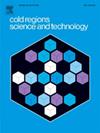冻融循环作用下蓝色混凝土颜色及力学性能退化的试验研究
IF 3.8
2区 工程技术
Q1 ENGINEERING, CIVIL
引用次数: 0
摘要
彩色混凝土广泛应用于主题公园路面,冻融循环会影响其力学和美学行为。本研究通过试验揭示了典型蓝色混凝土在氟氯烃作用下的劣化机理。配制了10例蓝色混凝土,研究了不同着色剂用量对混凝土养护龄期和纤维密度的影响。结果表明,水基着色剂由于表面着色剂分子密度的增加而提高了颜色的稳定性。此外,由于酞菁小分子的存在,可以提高密度和抗裂性,显著降低了FTCs下的强度损失和最大裂缝宽度。然而,水性着色剂可能会降低蓝色混凝土的机械性能。蓝色混凝土中掺入体色剂可使蓝色混凝土的抗折强度和抗压强度分别提高26.7% - 212.9%和20.1% - 40.5%,这是由于白水泥的再水化作用可以恢复冻损。此外,由于二氧化钛的能力,它们还可以保持颜色,二氧化钛可以覆盖混凝土的原始颜色。本文章由计算机程序翻译,如有差异,请以英文原文为准。
Color and mechanical property degradation of blue concrete under freeze-thaw cycles: An experimental study
Colored concrete is widely used in pavements of theme parks and its mechanical and aesthetic behaviors could be affected by freeze-thaw cycles (FTCs). In this study, experimentations were carried out to reveal the deterioration mechanism of typical blue concrete under FTCs. Ten cases of blue concrete in different colorant dosages were prepared to study the effect of curing age and FTCs. The results showed that water-based colorants improved the color stability due to the increased surface colorant molecular density. Furthermore, the strength loss under FTCs and maximum crack width significantly reduced due to the existence of small molecules of phthalocyanine that can enhance density and crack resistance. However, water-based colorants may reduce the mechanical properties of blue concrete. The incorporation of body colorants in blue concrete can enhance the flexural and compressive strengths of blue concrete by 26.7–212.9% and 20.1–40.5%, respectively, due to the rehydration of white cement that can recover the frost damage. Additionally, they also can maintain the color due to the ability of titanium dioxide which can cover the original color of concrete.
求助全文
通过发布文献求助,成功后即可免费获取论文全文。
去求助
来源期刊

Cold Regions Science and Technology
工程技术-地球科学综合
CiteScore
7.40
自引率
12.20%
发文量
209
审稿时长
4.9 months
期刊介绍:
Cold Regions Science and Technology is an international journal dealing with the science and technical problems of cold environments in both the polar regions and more temperate locations. It includes fundamental aspects of cryospheric sciences which have applications for cold regions problems as well as engineering topics which relate to the cryosphere.
Emphasis is given to applied science with broad coverage of the physical and mechanical aspects of ice (including glaciers and sea ice), snow and snow avalanches, ice-water systems, ice-bonded soils and permafrost.
Relevant aspects of Earth science, materials science, offshore and river ice engineering are also of primary interest. These include icing of ships and structures as well as trafficability in cold environments. Technological advances for cold regions in research, development, and engineering practice are relevant to the journal. Theoretical papers must include a detailed discussion of the potential application of the theory to address cold regions problems. The journal serves a wide range of specialists, providing a medium for interdisciplinary communication and a convenient source of reference.
 求助内容:
求助内容: 应助结果提醒方式:
应助结果提醒方式:


